 Six Ton Tank M1917 | |
 | |
| Location | Indianapolis, Indiana |
|---|---|
| Type | Military,Aviation |
Ropkey Armor Museum (today, known as the Ropkey Armor and Aviation Museum) is a military history museum in Indianapolis, Indiana. [1]
 Six Ton Tank M1917 | |
 | |
| Location | Indianapolis, Indiana |
|---|---|
| Type | Military,Aviation |
Ropkey Armor Museum (today, known as the Ropkey Armor and Aviation Museum) is a military history museum in Indianapolis, Indiana. [1]
The museum is privately owned by the Ropkey family. It stemmed from the founder Fred Ropkey's interest in military history and his past career as a tank platoon leader in the U.S. Marine Corps during the early 1950s. [2] The Ropkey Armor Museum closed July 29, 2017. Afterwards, the vehicle collection was downsized. Some pieces of the collection were distributed to other museums while the core collection was relocated by the Ropkeys to Indianapolis, Indiana. The museum lives on today as the Ropkey Armor and Aviation Museum with renewed focus given to historic aircraft and aviation history. [3] [4]
The museum collection consists of AFVs, soft skin vehicles, marine and aircraft.

Other exhibits are soft-skin military vehicles and aircraft. The aircraft include an Antonov An-2 [5] and the unique Bell X-14B. This aircraft was used for early research into VTOL until it was written off in a landing accident in 1981. It is currently being restored by the museum.
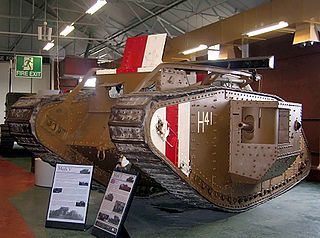
An armoured fighting vehicle or armored fighting vehicle (AFV) is an armed combat vehicle protected by armour, generally combining operational mobility with offensive and defensive capabilities. AFVs can be wheeled or tracked. Examples of AFVs are tanks, armoured cars, assault guns, self-propelled artilleries, infantry fighting vehicles (IFV), and armoured personnel carriers (APC).

A military armoredcar is a wheeled armoured fighting vehicle, historically employed for reconnaissance, internal security, armed escort, and other subordinate battlefield tasks. With the gradual decline of mounted cavalry, armored cars were developed for carrying out duties formerly assigned to light cavalry. Following the invention of the tank, the armoured car remained popular due to its faster speed, comparatively simple maintenance and low production cost. It also found favor with several colonial armies as a cheaper weapon for use in underdeveloped regions. During World War II, most armoured cars were engineered for reconnaissance and passive observation, while others were devoted to communications tasks. Some equipped with heavier armament could even substitute for tracked combat vehicles in favorable conditions—such as pursuit or flanking maneuvers during the North African campaign.
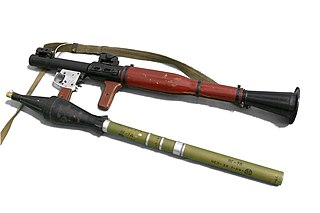
A Hand-held anti-tank grenade launcher (RPG) is a shoulder-fired anti-tank weapon that launches rockets equipped with a shaped-charge explosive warhead. Most RPGs can be carried by an individual soldier, and are frequently used as anti-tank weapons. These warheads are affixed to a rocket motor which propels the RPG towards the target and they are stabilized in flight with fins. Some types of RPG are reloadable with new anti-tank grenades, while others are single-use. RPGs are generally loaded from the front.

A technical, known as a non-standard tactical vehicle (NSTV) in United States military parlance, is a light improvised fighting vehicle, typically an open-backed civilian pickup truck or four-wheel drive vehicle modified to mount SALWs and heavy weaponry, such as a machine gun, automatic grenade launcher, anti-aircraft autocannon, rotary cannon, anti-tank weapon, anti-tank gun, ATGM, mortar, multiple rocket launcher, recoilless rifle, or other support weapon, etc.
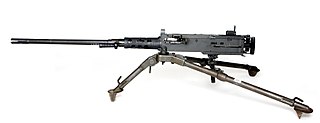
The M2 machine gun or Browning .50 caliber machine gun is a heavy machine gun that was designed near the end of World War I by John Browning. While similar to Browning's M1919 Browning machine gun, which was chambered for the .30-06 cartridge, the M2 uses Browning's larger and more powerful .50 BMG cartridge. The design has had many designations; the official U.S. military designation for the infantry type is Browning Machine Gun, Cal. .50, M2, HB, Flexible. It has been used against infantry, light armored vehicles, watercraft, light fortifications, and low-flying aircraft.
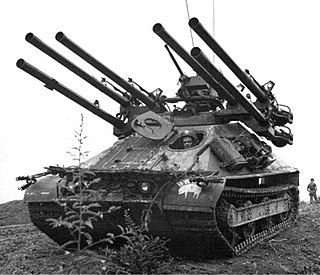
Ontos, officially the Rifle, Multiple 106 mm, Self-propelled, M50, was an American light armored tracked anti-tank vehicle developed in the 1950s.

The Flying Heritage & Combat Armor Museum is a U.S.A. 501(c)(3) nonprofit organization dedicated to the display and preservation of rare military aircraft, tanks and other military equipment. The museum reopened on the Memorial Day Weekend 2023.
Model military vehicles are miniature versions of military vehicles. They range in size and complexity; from simplified small-scale models for wargaming, to large, super-detailed renditions of specific real-life vehicles.
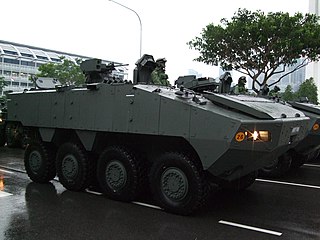
The Terrex Infantry Carrier Vehicle (ICV) is an armoured fighting vehicle (AFV) developed by ST Engineering of Singapore and Timoney Technology of Ireland, and produced by ST Engineering Land Systems for the Singapore Army as well as by Turkish auto-maker Otokar as the Yavuz (AV-82) for the Turkish military.

Military vehicles are commonly armoured to withstand the impact of shrapnel, bullets, shells, rockets, and missiles, protecting the personnel inside from enemy fire. Such vehicles include armoured fighting vehicles like tanks, aircraft, and ships.

The Kubinka Tank Museum is a large military museum in Kubinka, Odintsovsky District, Moscow Oblast, Russia where tanks, armoured fighting vehicles (AFVs) and their relevant information are displayed and showcased. The museum consists of open-air and indoor permanent exhibitions of many famous tanks and armored vehicles from throughout the 20th and 21st centuries. It also houses and displays many unique, unusual and one-of-a-kind military vehicles of which there are very few remaining examples, such as the German Panzer VIII Maus super-heavy tank, Troyanov's Object 279 Kotin heavy tank, the Karl-Gerät heavy self-propelled artillery, and the Object 120 Su-152 "Taran" tank destroyer, amongst other single or limited-production prototypes from the Soviet Union and Nazi Germany.

A self-sealing fuel tank (SSFT) is a type of fuel tank, typically used in aircraft fuel tanks or fuel bladders, that prevents them from leaking fuel and igniting after being damaged.

The Cadillac Gage Commando, frequently denoted as the M706 in U.S. military service, is an American armored car designed to be amphibious. It was engineered by Cadillac Gage specifically for the United States Military Police Corps during the Vietnam War as an armed convoy escort vehicle. The Commando was one of the first vehicles to combine the traditionally separate roles of an armored personnel carrier and a conventional armored car, much like the Soviet BTR-40. Its notable height, amphibious capability, and waterproofed engine allowed American crews to fight effectively in the jungles of Vietnam by observing their opponents over thick vegetation and fording the country's deep rivers.
The Marmon-Herrington Company, Inc. is an American manufacturer of axles and transfer cases for trucks and other vehicles. Earlier, the company built military vehicles and some tanks during World War II, and until the late 1950s or early 1960s was a manufacturer of trucks and trolley buses. Marmon-Herrington had a partnership with Ford Motor Company, producing trucks and other commercial vehicles, such as buses. The company may be best known for its all-wheel-drive conversions to other truck maker's units, especially to Ford truck models. Founded in 1931, Marmon-Herrington was based in Indianapolis, Indiana, with a plant in Windsor, Ontario, and remained in Indianapolis until 1963. It is now based in Louisville, Kentucky.

The M1117 armored security vehicle is an internal security vehicle based on the V-100 and V-150 Commando series of armored cars. It was developed in the late 1990s for service with the United States' Military Police Corps. The first prototypes appeared in February 1997 and serial production of the M1117 commenced between 1999 and early 2000.

The Military Museum of the Chinese People's Revolution is the national military museum of China, located in Haidian, Beijing. The collection mainly focuses on military equipments and cultural relics reflecting the military history of the People's Liberation Army, ancient and modern Chinese military history, and world military history.

The Royal Tank Museum is a military museum in Amman, Jordan, inaugurated on January 29, 2018. Located next to the King Abdullah II Park in Al Muqabalain. The Royal Tank Museum spans an area of approximately 20,000 square meters and houses around 110 tanks and armored vehicles from Jordan, Arab nations, and foreign countries, displayed in chronological order. The collection includes a number of American, British, Soviet, and German-made vehicles, with a dedicated hall showcasing local military industries. The museum features both original and restored rare items, illustrating the historical evolution of military vehicles since 1915. The museum's design was created by Jordanian architect Zaid Dawood.
The Islamic State (IS) is known to extensively use armoured fighting vehicles (AFV) in both conventional and unconventional armoured warfare. From 2013/14, the military of IS captured hundreds of AFVs, including main battle tanks and armoured personnel carriers, and pressed them into service in Syria and Iraq. Besides using them conventionally, IS also converted many AFVs into vehicle-borne improvised explosive devices (VBIEDs) which were used to great effect in suicide attacks, as well as armouring regular vehicles for similar attacks. By 2017, most of the Islamic State's armour in the Middle East had been destroyed by the various anti-IS forces; however, African affiliates of IS are known to continue to operate AFVs.